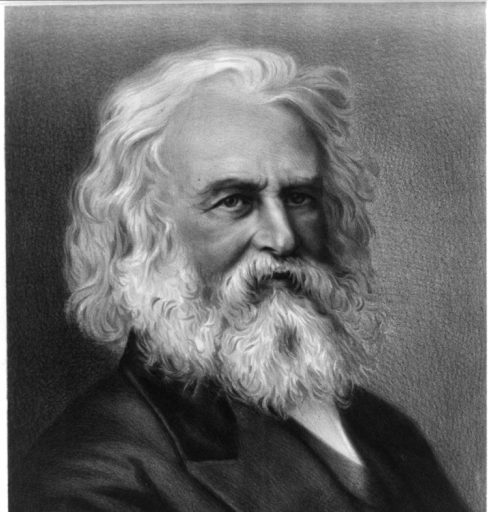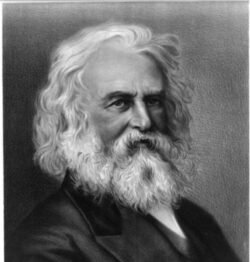Cajuns in Literature
Acadians, Cajuns, and their history became part of American literature, often represented through romantic myth.

Courtesy of Library of Congress Prints and Photographs Division
Henry Wadsworth Longfellow. unidentified
Since at least the mid-nineteenth century, Louisiana’s Cajun citizens have provided rich subject material for American writers ranging from Henry Wadsworth Longfellow to Tim Gautreaux. Cajuns descend from the Acadians—French Catholics who settled the maritime provinces of Canada now known as Nova Scotia, Prince Edward Island, and New Brunswick. Expelled from the region by the British in 1755, the Acadians migrated to various places, including Louisiana. Acadians, Cajuns, and their history soon became part of American literature, especially through the work of Longfellow, who depicted the expulsion’s effect on two young lovers in his epic 1847 poem, “Evangeline, A Tale of Acadie.” While Longfellow’s poem romanticizes the first Cajuns and their history, other writers have depicted them as isolated, ignorant folk. By the end of the twentieth century, Cajuns responded to such portrayals by creating their own fictional Cajun characters.
Nineteenth Century Literature
Longfellow’s poem first brought the Acadians and their dispersal to national attention. The story of Evangeline’s search for her lost love, Gabriel, after their separation during the forced migration created a romanticized mythology that the Louisiana tourism industry continues to promote. This is particularly apparent in St. Martinville, where one can visit the Evangeline oak along Bayou Têche and view the Evangeline statue. Elements of Longfellow’s story were repeated and expanded in Sidonie de la Houssaye’s 1888 novel Pouponne et Balthazar and Felix Voorhies’ Acadian Reminiscences: The True Story of Evangeline, published in 1907.
By the second half of the nineteenth century, however, this romanticized depiction shifted, as Cajuns were increasingly represented as simple folk in the fiction of George Washington Cable and Kate Chopin. Unlike Longfellow, who never traveled to Louisiana, Cable not only lived in the state but also recorded his observations about Cajuns in a notebook. Cable relied on his notes while writing Bonaventure: A Prose Pastoral of Acadian Louisiana (1888), a tale of the honorable and simple Acadians. The title character, a Creole, advocates English education as a tool for Acadian advancement, a position supported by Cable. While the older Acadians react negatively to such change, the younger generation embraces Bonaventure’s English and American lessons.
Although originally from St. Louis, Missouri, writer Kate Chopin lived in Louisiana from 1870 to 1884. Her short stories and novels greatly benefited from her experiences with, and knowledge of, Creoles and Cajuns in Louisiana. Chopin identifies her Acadian characters as “‘Cadians” in such stories as “A Rude Awakening” and “A Gentleman of Bayou Têche,” both published in Bayou Folk (1894), mimicking the Acadian descendants’ pronunciation of this self-identifying label. But she also uses the term “Cajun,” the American corruption of the label, in the stories “In Sabine” and “At the ‘Cadian Ball,” published in the same collection. Her second collection of stories, A Night in Acadie (1897), includes “At Chênière Caminada,” which introduces the character Madame Antoine, a Cajun mother. In Chopin’s 1899 novel, The Awakening, Antoine provides Edna Pontellier with a place to escape from Creole society. Chopin’s Cajun characters are simple folk who live between racial and class categories and among the multiethnic populations of Louisiana. They are often contrasted with the upper class white Creoles of the area.
Twentieth Century Literature
By the twentieth century, the terms Acadian and ‘Cadian had been largely replaced by the label Cajun. Authors such as Ada Jack Carver and Elma Godchaux depicted the changes that occurred as Cajuns became less isolated and more Americanized during the first half of the century. Shirley Ann Grau’s first novel, The Hard Blue Sky (1955), for example, reveals the influence of American culture on Cajuns, as well as their struggles with nature and harsh, isolated living conditions. In Grau’s The Condor Passes (1971), Robert Caillet is a poor Cajun who rises in class status by marrying his benefactor’s daughter. Caillet’s anger toward his benefactor, combined with Grau’s unsympathetic portrayal of Caillet, suggest the writer’s ambivalence about this Americanization.
No longer the innocent, romanticized people of Longfellow’s imagination, Cajun characters in twentieth-century American literature often reflect the complexities of modern society. In novels such as Of Love and Dust (1967) and A Gathering of Old Men (1983), for example, African American writer Ernest Gaines forefronts the relationship between Cajuns and Africans Americans, as they compete for land in a state still dominated by racial prejudices. Through the character of Dave Robicheaux, detective writer James Lee Burke suggests that Cajuns have become increasingly distant from the simpler way of life Robicheaux’s father once lived. The Cajun detective is haunted by guilt as a result of his personal experiences in the Vietnam War and his culture’s historical support of slavery and abuses against Native Americans.
During the late twentieth century, Cajuns began to write poetry and fiction about themselves and their experiences in Louisiana. These writers acknowledge the pressure to become increasing Americanized while also celebrating their culture’s uniqueness. In Marshland Trinity (1997), Chris Segura captures the tension between becoming more American and taking pride in being Cajun. In the novel Leechtime (1986) and What They Wrote on the Bathhouse Walls: Yen’s Marina, Chinese Bayou, Louisiana (1988), a poetry collection, Albert Belisle Davis also writes of a Cajun world far removed from both Longfellow’s Eden and Cable’s pastoral ideal. Similarly, in The Divine Secrets of the Ya-Ya Sisterhood (1996), Rebecca Wells features a Cajun French mother, Genevieve, who is looked down upon by her husband but adored by the younger generation because of her joie de vivre.
One group of Cajun writers chose to write and publish their works in Cajun French. Zachary Richard and Jean Arceneaux (a pseudonym for folklorist Barry Jean Ancelet) published Cris sur le bayou, a collection of Cajun French poems, in 1980. Driven in part by the need to prove Cajun French could be written down, these writers also showed that the language could be used to write creatively. Inspired by their work, Cajun writers such as Antoine Bourque (a pseudonym for Cajun historian Carl Brasseaux) followed with his short story collection, Trois saisons (1988). Richard Guidry published C’est p’us pareil, also written in Cajun French, in 1982. The move to represent themselves in literature, in both English and Cajun French, marked a significant moment in the literary representation of Cajuns.
Francophone literature written by non-Cajun authors in the late twentieth century proves the international appeal of the Louisiana ethnicity. Antonine Maillet, Acadian novelist, playwright, and winner of the 1979 Prix Goncourt for Pélagie-la-Charrette, wrote “Évangéline Deusse,” a 1975 play, about a prostitute searching for independence. Another Prix Goncourt winner (1989), French author and director Jean Vautrin, wrote about three generations of a Cajun family in his novel Un Grand Pas Vers Le Bon Dieu.
Twenty-First Century Literature
Cajuns continue to be popular characters in American literature, as evidenced by the number of suspense and romance novels that include them as characters. Bestselling authors Julie Garwood and Nora Roberts have proven that Cajuns can be romantic leads, while Faye Kellerman, Julie Smith, Barbara Hambly, D. J. Donaldson, Dick Lochte, and Abigail Padgett have demonstrated that Cajuns are not immune to crime. The number of Cajun characters in popular fiction points to Americans’ continuing fascination with this particular Louisiana ethnic group.
